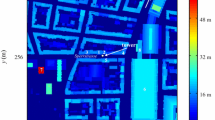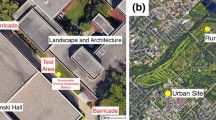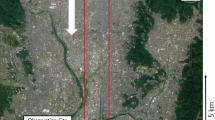Abstract
Although predictability is a subject of great importance in atmospheric modelling, there has been little research on urban boundary-layer flows. Here the predictability of street-canyon flow is examined numerically via large-eddy simulation of a unit-aspect-ratio canyon and neutrally stratified atmosphere. In spectral space there is indication of cascade-like behaviour away from the canyon at early times, but the error growth is essentially independent of scale inside the canyon; in physical space the error field is rather inhomogeneous and shows clear differences among the canyon, shear layer and inertial sublayer. The error growth is largely driven by the shear layer: errors generated above roof level are advected into the canyon while contributions from intermittent bursting and in situ development within the canyon play a relatively minor role. This work highlights differences between the predictability of urban flows and canonical turbulent flows and should be useful in developing modelling strategies for more realistic time-dependent urban flows.










Similar content being viewed by others
Notes
Although the \(y\)-axis has been clipped for clarity in Fig. 3, \(\langle {r}_{n_x} \rangle >0\) even for the largest scales.
References
Barlow J, Dobre A, Smalley R, Arnold S, Tomlin A, Belcher S (2009) Referencing of street-level flows measured during the DAPPLE 2004 campaign. Atmos Environ 43(34):5536–5544. doi:10.1016/j.atmosenv.2009.05.021
Basdevant C, Philipovitch T (1994) On the validity of the “Weiss criterion” in two-dimensional turbulence. Physica D 73(1–2):17–30. doi:10.1016/0167-2789(94)90222-4
Basdevant C, Legras B, Sadourny R, Béland M (1981) A study of barotropic model flows: Intermittency, waves and predictability. J Atmos Sci 38(11):2305–2326. doi:10.1175/1520-0469(1981)038<2305:ASOBMF>2.0.CO;2
Belcher SE (2005) Mixing and transport in urban areas. Philos Trans R Soc A 363:2947–2968
Brown M, Lawson R, Decroix D, Lee R (2000) Mean flow and turbulence measurements around a 2-D array of buildings in a wind tunnel. In: Proceedings of the 11th joint AMS/AWMA conference in applied air pollution meteorology
Cheng W, Liu CH (2011) Large-eddy simulation of flow and pollutant transports in and above two-dimensional idealized street canyons. Boundary-Layer Meteorol 139(3):411–437. doi:10.1007/s10546-010-9584-y
Coceal O, Dobre A, Thomas TG (2007) Unsteady dynamics and organized structures from DNS over an idealized building canopy. Int J Climatol 27(14):1943–1953. doi:10.1002/joc.1549
Cui Z, Cai X, J Baker C (2004) Large-eddy simulation of turbulent flow in a street canyon. Q J R Meteorol Soc 130(599):1373–1394. doi:10.1256/qj.02.150
Deardorff J (1980) Stratocumulus-capped mixed layers derived from a three-dimensional model. Boundary-Layer Meteorol 18(4):495–527. doi:10.1007/BF00119502
Dobre A, Arnold S, Smalley R, Boddy J, Barlow J, Tomlin A, Belcher S (2005) Flow field measurements in the proximity of an urban intersection in London, UK. Atmos Environ 39(26):4647–4657. doi:10.1016/j.atmosenv.2005.04.015
Durran DR, Gingrich M (2014) Atmospheric predictability: why butterflies are not of practical importance. J Atmos Sci 71(7):2476–2488. doi:10.1175/JAS-D-14-0007.1
Foken T (2008) Micrometeorology. Springer, Berlin, p 306
Inagaki A, Castillo M, Yamashita Y, Kanda M, Takimoto H (2012) Large-eddy simulation of coherent flow structures within a cubical canopy. Boundary-Layer Meteorol 142(2):207–222. doi:10.1007/s10546-011-9671-8
Kalnay E (2002) Atmospheric modelling, data assimilation and predictability. Cambridge University Press, Cambridge, p 364
Kanda M (2006) Large-eddy simulations on the effects of surface geometry of building arrays on turbulent organized structures. Boundary-Layer Meteorol 118(1):151–168. doi:10.1007/s10546-005-5294-2
Leith CE, Kraichnan RH (1972) Predictability of turbulent flows. J Atmos Sci 29(6):1041–1058.doi:10.1175/1520-0469(1972)029<1041:POTF>2.0.CO;2
Letzel MO, Krane M, Raasch S (2008) High resolution urban large-eddy simulation studies from street canyon to neighbourhood scale. Atmos Environ 42(38):8770–8784. doi:10.1016/j.atmosenv.2008.08.001
Liu CH, Barth M (2002) Large-eddy simulation of flow and scalar transport in a modeled street canyon. J Appl Meteorol 41(6):660–673
Lorenz EN (1969) The predictability of a flow which possesses many scales of motion. Tellus 21(3):289–307. doi:10.1111/j.2153-3490.1969.tb00444.x
Meroney RN, Pavageau M, Rafailidis S, Schatzmann M (1996) Study of line source characteristics for 2-D physical modelling of pollutant dispersion in street canyons. J Wind Eng Ind Aerodyn 62(1):37–56. doi:10.1016/S0167-6105(96)00057-8
Métais O, Lesieur M (1986) Statistical predictability of decaying turbulence. J Atmos Sci 43(9):857–870. doi:10.1175/1520-0469(1986)043<0857:SPODT>2.0.CO;2
Michioka T, Sato A (2012) Effect of incoming turbulent structure on pollutant removal from two-dimensional street canyon. Boundary-Layer Meteorol 145(3):469–484. doi:10.1007/s10546-012-9733-6
Ngan K, Eperon GE (2012) Middle atmosphere predictability in a numerical weather prediction model: revisiting the inverse error cascade. Q J R Meteorol Soc 138(666):1366–1378. doi:10.1002/qj.984
Ngan K, Straub DN, Bartello P (2004) Three-dimensionalization of freely-decaying two-dimensional turbulence. Phys Fluids 16(8):2918–2932. doi:10.1063/1.1763191
Ngan K, Straub DN, Bartello P (2005) Aspect ratio effects in quasi-two-dimensional turbulence. Phys Fluids 17(12):125102. doi:10.1063/1.2139685
Ngan K, Bartello P, Straub DN (2009) Predictability of rotating stratified turbulence. J Atmos Sci 66(5):1384–1400. doi:10.1175/2008JAS2799.1
Oke T (1988) Street design and urban canopy layer climate. Energy Build 11(1–3):103–113. doi:10.1016/0378-7788(88)90026-6
Palmer TN (2000) Predicting uncertainty in forecasts of weather and climate. Rep Prog Phys 63(2):71
Palmer T, Hagedorn R (eds) (2006) Predictability of weather and climate. Cambridge University Press, Cambridge, p 702
Park SB, Baik JJ (2013) A large-eddy simulation study of thermal effects on turbulence coherent structures in and above a building array. J Appl Meteorol Climatol 52(6):1348–1365. doi:10.1175/JAMC-D-12-0162.1
Park SB, Baik JJ, Raasch S, Letzel MO (2012) A large-eddy simulation study of thermal effects on turbulent flow and dispersion in and above a street canyon. J Appl Meteorol Climatol 51(5):829–841. doi:10.1175/JAMC-D-11-0180.1
Raasch S, Schröter M (2001) PALM—a large-eddy simulation model performing on massively parallel computers. Meteorol Z 10(5):363–372. doi:10.1127/0941-2948/2001/0010-0363
Straub DN (2003) Instability of 2D flows to hydrostatic 3D perturbations. J Atmos Sci 60(1):79–102. doi:10.1175/1520-0469(2003)060<0079:IOFTHP>2.0.CO;2
Takimoto H, Sato A, Barlow J, Moriwaki R, Inagaki A, Onomura S, Kanda M (2011) Particle image velocimetry measurements of turbulent flow within outdoor and indoor urban scale models and flushing motions in urban canopy layers. Boundary-Layer Meteorol 140(2):295–314. doi:10.1007/s10546-011-9612-6
Tribbia JJ, Baumhefner DP (2004) Scale interactions and atmospheric predictability: an updated perspective. Mon Weather Rev 132(3):703–713. doi:10.1175/1520-0493(2004)132<0703:SIAAPA>2.0.CO;2
Uehara K, Murakami S, Oikawa S, Wakamatsu S (2000) Wind tunnel experiments on how thermal stratification affects flow in and above urban street canyons. Atmos Environ 34(10):1553–1562. doi:10.1016/S1352-2310(99)00410-0
Weiss J (1991) The dynamics of enstrophy transfer in two-dimensional hydrodynamics. Physica D 48(2–3):273–294. doi:10.1016/0167-2789(91)90088-Q
Wicker LJ, Skamarock WC (2002) Time-splitting methods for elastic models using forward time schemes. Mon Weather Rev 130(8):2088–2097. doi:10.1175/1520-0493(2002)130<2088:TSMFEM>2.0.CO;2
Acknowledgments
Helpful comments and suggestions were received from the anonymous referees. This work was supported financially by City University of Hong Kong through a Strategic Research Grant (Project 7004165).
Author information
Authors and Affiliations
Corresponding author
Appendix
Appendix
Here we compare our LES simulations with the wind-tunnel measurements of Brown et al. (2000). Their experimental set-up consisted of six identical street canyons of unit aspect ratio; data from the sixth canyon, which correspond to a fully developed turbulent flow, are used for the comparison.
The current LES shows generally good agreement with the experimental data and previous LES studies (Cui et al. 2004; Cheng and Liu 2011). Figure 11 shows vertical profiles of \(\langle u\rangle \) normalized by \(\langle U_\mathrm{s}\rangle \), where \(\langle U_\mathrm{s}\rangle \) is the spanwise-averaged value of \(u\) in the shear layer, \(H\le z \le 1.5H\). The agreement is very good. Figure 12 compares second-order statistics, namely vertical profiles of TKE, \(\langle q \rangle \), normalized by its average value in the shear layer. There is reasonable agreement except for the case \(x=0.4H\). However, other LES simulations also show an anomalous peak in the TKE close to the roof level (Liu and Barth 2002; Cui et al. 2004).
Comparison of normalized streamwise velocity profiles for the current LES (solid blue curve) and the experimental data of Brown et al. (2000) (green circles): a \(x = -0.4H\), b \(x = -0.25H\), c \(x = 0H\), d \(x = 0.25H\), e \(x = 0.4H\)
Comparison of normalized TKE profiles for the current LES (solid blue curve) and the experimental data of Brown et al. (2000) (green circle) a \(x = -0.4H\), b \(x = -0.25H\), c \(x = 0\), d \(x = 0.25H\), e \(x = 0.4H\)
Rights and permissions
About this article
Cite this article
Lo, K.W., Ngan, K. Predictability of Turbulent Flow in Street Canyons. Boundary-Layer Meteorol 156, 191–210 (2015). https://doi.org/10.1007/s10546-015-0014-z
Received:
Accepted:
Published:
Issue Date:
DOI: https://doi.org/10.1007/s10546-015-0014-z






